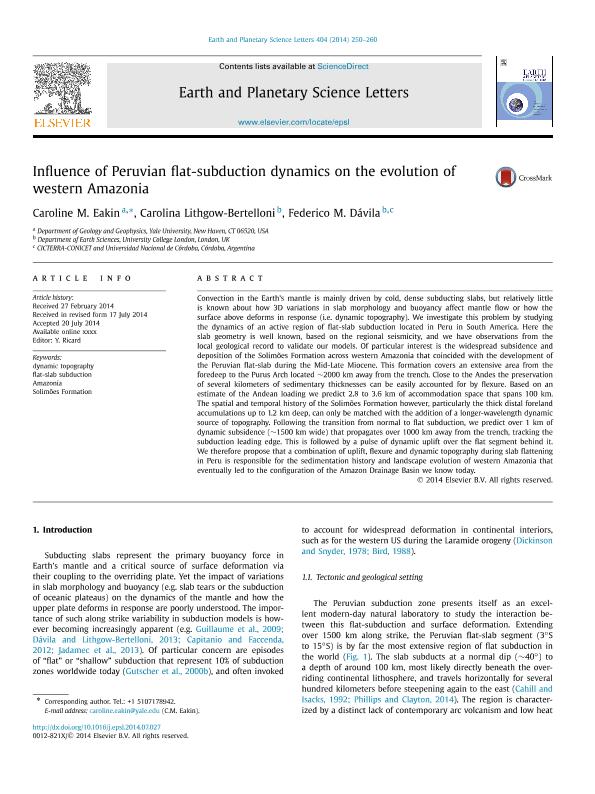Mostrar el registro sencillo del ítem
dc.contributor.author
Eakin, Caroline M.
dc.contributor.author
Lithgow Bertelloni, Carolina
dc.contributor.author
Davila, Federico Miguel

dc.date.available
2018-01-02T21:54:49Z
dc.date.issued
2014-10
dc.identifier.citation
Davila, Federico Miguel; Lithgow Bertelloni, Carolina; Eakin, Caroline M.; Influence of Peruvian flat-subduction dynamics on the evolution of western Amazonia; Elsevier; Earth and Planetary Science Letters; 404; 10-2014; 250-260
dc.identifier.issn
0012-821X
dc.identifier.uri
http://hdl.handle.net/11336/32070
dc.description.abstract
Convection in the Earth?s mantle is mainly driven by cold, dense subducting slabs, but little is known about how 3D variations in slab morphology and buoyancy affect mantle flow or how the surface above deforms in response (i.e. dynamic topography). We investigate this problem by studying the dynamics of an active region of flat-slab subduction located in Peru in South America. Here the slab geometry is well known, based on the regional seismicity, and we have observations from the local geological record to validate our models. Of particular interest is the widespread subsidence and deposition of the Solimões Formation across western Amazonia that coincided with the development of the Peruvian flat-slab during the Mid-Late Miocene. This formation covers an extensive area from the foredeep to the Purus Arch located ~2000 km away from the trench. Close to the Andes the preservation of several kilometers of sedimentary thicknesses can be easily accounted for by flexure. Based on an estimate of the Andean loading we predict 2.8 to 3.6 km of accommodation space that spans 100 km. The spatial and temporal history of the Solimões Formation however, particularly the thick distal foreland accumulations up to 1.2 km deep, can only be matched with the addition of a longer-wavelength dynamic source of topography. Following the transition from normal to flat subduction, we predict over 1 km of dynamic subsidence (~1500 km wide) that propagates over 1000 km away from the trench, tracking the subduction leading edge. This is followed by a pulse of dynamic uplift over the flat segment behind it. We therefore propose that a combination of uplift, flexure and dynamic topography during slab flattening in Peru is responsible for the sedimentation history and landscape evolution of western Amazonia that eventually led to the configuration of the Amazon Drainage Basin we know today.
dc.format
application/pdf
dc.language.iso
eng
dc.publisher
Elsevier

dc.rights
info:eu-repo/semantics/openAccess
dc.rights.uri
https://creativecommons.org/licenses/by-nc-sa/2.5/ar/
dc.subject
Amazonas
dc.subject
Geodinámica
dc.subject.classification
Meteorología y Ciencias Atmosféricas

dc.subject.classification
Ciencias de la Tierra y relacionadas con el Medio Ambiente

dc.subject.classification
CIENCIAS NATURALES Y EXACTAS

dc.title
Influence of Peruvian flat-subduction dynamics on the evolution of western Amazonia
dc.type
info:eu-repo/semantics/article
dc.type
info:ar-repo/semantics/artículo
dc.type
info:eu-repo/semantics/publishedVersion
dc.date.updated
2017-12-28T17:49:06Z
dc.journal.volume
404
dc.journal.pagination
250-260
dc.journal.pais
Países Bajos

dc.journal.ciudad
Amsterdam
dc.description.fil
Fil: Eakin, Caroline M.. University of Yale; Estados Unidos
dc.description.fil
Fil: Lithgow Bertelloni, Carolina. University College London; Estados Unidos
dc.description.fil
Fil: Davila, Federico Miguel. University College London; Estados Unidos. Consejo Nacional de Investigaciones Científicas y Técnicas. Centro Científico Tecnológico Conicet - Córdoba. Centro de Investigaciones en Ciencias de la Tierra. Universidad Nacional de Córdoba. Facultad de Ciencias Exactas Físicas y Naturales. Centro de Investigaciones en Ciencias de la Tierra; Argentina
dc.journal.title
Earth and Planetary Science Letters

dc.relation.alternativeid
info:eu-repo/semantics/altIdentifier/url/https://www.sciencedirect.com/science/article/pii/S0012821X14004828
dc.relation.alternativeid
info:eu-repo/semantics/altIdentifier/doi/https://doi.org/10.1016/j.epsl.2014.07.027
Archivos asociados
